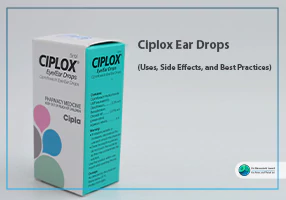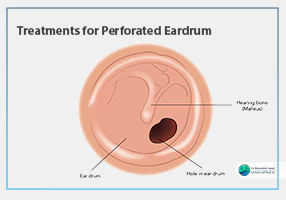Ciplox Ear Drops (ciprofloxacin): Uses, Side Effects & Best Practices
Ciplox Ear Drops, containing the active ingredient ciprofloxacin, are among the most widely prescribed medications for treating bacterial infections of the ear. These drops belong to a class of antibiotics known as fluoroquinolones, which effectively eliminate bacteria responsible for various ear infections, including otitis externa (outer ear infection) and otitis media (middle ear infection).
Whether prescribed after ear surgery, for swimmer’s ear, or to manage chronic bacterial ear conditions, Ciplox Ear Drops provide targeted, localized antibiotic therapy with minimal systemic side effects. This article provides a complete guide on how Ciplox works, when to use it, how to apply it properly, and what precautions to follow.
What Are Ciplox Ear Drops?
Ciplox Ear Drops are a topical antibiotic solution containing Ciprofloxacin Hydrochloride as the main active component. Each milliliter of solution usually contains 0.3% ciprofloxacin.
They are designed for local administration in the ear, helping to fight bacterial infections directly at the site without the need for oral antibiotics. Ciplox is manufactured by Cipla Ltd., a trusted global pharmaceutical company.
Composition
Active ingredient: Ciprofloxacin Hydrochloride 0.3%
Inactive ingredients: Benzalkonium chloride (preservative), sodium chloride, and purified water
What Are Ear Infections?
Ear infections occur when bacteria or other pathogens invade the outer or middle ear, causing pain, swelling, and discharge. Otitis externa affects the ear canal, often due to water exposure, while otitis media impacts the middle ear, common in children. Ciplox targets bacterial infections, offering rapid relief when used correctly.
Importance of Antibiotic Ear Drops
Antibiotic ear drops like Ciplox deliver medication directly to the infection site, ensuring faster action than oral antibiotics. Ciprofloxacin’s broad-spectrum activity makes it effective against common ear pathogens. Proper use is critical to avoid resistance and ensure complete recovery.
How Ciplox Ear Drops Work
Ciplox ear drops contain ciprofloxacin, a fluoroquinolone antibiotic that kills bacteria by disrupting their DNA replication. This targeted action eliminates infection-causing bacteria, reducing symptoms like pain and swelling. The drops are particularly effective for bacterial, not viral or fungal, infections.
Mechanism of Action
Ciprofloxacin inhibits bacterial enzymes, preventing cell division and growth. This action targets bacteria like Pseudomonas aeruginosa, a common cause of swimmer’s ear. By clearing the infection, Ciplox restores ear health and alleviates associated discomfort. The drops work best when applied consistently as prescribed.
Common Conditions Treated with Ciplox Ear Drops
1. Otitis Externa (Swimmer’s Ear)
A common infection of the outer ear canal, often caused by moisture or bacteria. Ciplox helps clear the infection, reduce swelling, and relieve pain.
Also read: Treatment of acute otitis externa with ciprofloxacin 0.2% ear drops
2. Otitis Media (Middle Ear Infection)
In cases where there is ear discharge due to a ruptured eardrum or after ear surgery, Ciplox drops are used to control bacterial infection.
3. Post-Surgical Ear Care
After procedures such as tympanoplasty or mastoidectomy, Ciplox is prescribed to prevent infection and promote healing.
4. Chronic Suppurative Otitis Media
In long-standing infections with continuous discharge, Ciplox helps manage bacterial overgrowth and reduce inflammation.
How to Use Ciplox Ear Drops Correctly
Proper use of Ciplox Ear Drops is essential to ensure that the medication reaches the infected area effectively and works as intended. Incorrect technique can reduce its effectiveness or even cause irritation and contamination. Follow these detailed instructions to get the best results from your treatment.

Step-by-Step Guide for Applying Ciplox Ear Drops
1. Wash Your Hands Thoroughly
Before touching the ear or the bottle, wash your hands with soap and warm water for at least 20 seconds.
This helps prevent introducing any new bacteria into the ear canal and keeps the medication sterile.
💡 Tip: Dry your hands with a clean towel or tissue to avoid introducing moisture or lint into the ear.
2. Prepare the Ear Drops
Hold the Ciplox Ear Drops bottle in your hands for 1–2 minutes to warm it slightly.
Cold drops can cause discomfort, vertigo, or a sudden spinning sensation (especially in children or those with a sensitive inner ear).
⚠️ Do not heat the bottle with hot water or a microwave. Body heat is enough to bring it to a comfortable temperature.
3. Position Yourself Properly
Sit down and tilt your head sideways, with the affected ear facing upward. Alternatively, you can lie on your side if that feels more stable.
This position ensures that the drops flow deep into the ear canal rather than dripping out.
If you’re applying the drops to a child, have them lie down with their head turned sideways and keep them calm during application.
4. Straighten the Ear Canal
Gently pull the ear lobe to help the drops reach the deeper part of the ear canal:
- For adults: pull the ear upward and backward.
- For children under 3 years: pull the ear downward and backward.
This simple action straightens the natural curve of the ear canal, allowing the drops to travel further inside for better absorption.
5. Apply the Prescribed Number of Drops
Using the dropper provided, carefully instill the exact number of drops prescribed by your doctor — typically 2–4 drops in the affected ear.
Avoid squeezing too hard, as this may cause too much solution to enter or splash.
⚠️ Important: Do not let the dropper tip touch your ear, fingers, or any surface. Contact may contaminate the medicine and lead to reinfection.
6. Allow Time for Absorption
Keep your head tilted or remain lying down for at least 2–3 minutes after applying the drops.
This allows the solution to penetrate fully and coat the infected area of the ear canal.
If both ears are infected, wait about 5 minutes before turning your head to treat the other side.
💡 Optional: You can place a small piece of clean cotton at the entrance of the ear (not deep inside) to prevent the drops from leaking out. Remove it after 15–20 minutes.
7. Close and Store the Bottle Properly
After use, wipe the dropper tip gently with a clean tissue, close the cap tightly, and store the bottle upright in a cool, dry place.
This prevents contamination and ensures the medication remains effective.
Never share your ear drops with others, even if they have similar symptoms. Each person’s ear condition and bacterial cause may differ.
Typical Dosage and Duration
- Usual dose: 2–4 drops in the affected ear, twice daily (every 12 hours).
- Treatment duration: Usually 5–10 days, depending on infection severity and your doctor’s instructions.
- Missed dose: Apply as soon as you remember, but skip it if it’s almost time for the next one.
Do not double the dose.
Always complete the full course even if symptoms improve earlier. Stopping too soon can cause bacteria to survive and the infection to return.
Additional Application Tips
- Do not use ear drops immediately after swimming or bathing; dry the outer ear gently first.
- If you’re using multiple ear medications, wait at least 10–15 minutes between each product to avoid dilution or interference.
- Avoid inserting ear buds, cotton swabs, or fingers into the ear after applying drops, as this may irritate the canal or push bacteria deeper.
- If the solution becomes cloudy, discolored, or has particles, discard it, do not use.
When to Seek Help
Contact your doctor or ENT specialist if:
- There is no improvement after 3–4 days of correct use.
- You experience increased pain, swelling, or discharge.
- You feel dizziness, ringing in the ear (tinnitus), or hearing loss after applying the drops.
These may indicate either a worsening infection or an allergic reaction requiring medical review.
Possible Side Effects of Ciplox Ear Drops
Ciplox Ear Drops (Ciprofloxacin) are generally safe and well-tolerated when used as directed by a healthcare professional. Because they act locally in the ear canal, the risk of systemic (whole-body) side effects is extremely low compared to oral antibiotics.
However, as with all medications, some individuals may experience mild local reactions or, rarely, allergic or hypersensitivity responses.
Understanding these possible side effects helps ensure safe and confident use.
1. Mild Local Reactions (Common and Usually Temporary)
These are the most frequently reported side effects, often appearing within the first few applications. They are usually mild, short-lived, and self-limiting.
a. Mild Burning or Stinging Sensation
- Description: A temporary warm, stinging, or tingling feeling inside the ear right after applying the drops.
- Cause: The medication’s slightly acidic pH and antibacterial components can irritate sensitive ear tissue.
- Duration: Usually lasts a few seconds to a minute.
- What to Do: This is normal and does not require stopping the medication unless it becomes intense or persistent.
b. Itching or Mild Irritation
- Description: A light itching or tickling feeling in the ear canal.
- Cause: Minor irritation of the ear lining, especially in those with dry skin, eczema, or pre-existing inflammation.
- Management: Avoid scratching or inserting anything into the ear. If the sensation worsens, contact your doctor to rule out fungal overgrowth or allergy.
c. Ear Discomfort or Fullness
- Description: A feeling of pressure, fullness, or mild pain after applying drops.
- Cause: The volume of liquid temporarily displaces air in the canal or contacts inflamed tissue.
- What to Do: Keep your head tilted for a few minutes after application to allow proper absorption.
If discomfort continues beyond 10–15 minutes, consult your ENT specialist.
d. Dizziness or Vertigo
- Description: A brief spinning or lightheaded sensation that may occur after using cold ear drops.
- Cause: The temperature difference between cold liquid and body temperature can stimulate the inner ear’s balance system.
- Prevention: Warm the bottle in your hands for a minute before use to avoid temperature shock.
- When to Seek Help: If dizziness lasts longer than a few minutes or occurs repeatedly, consult your doctor.
2. Allergic or Hypersensitivity Reactions (Rare)
Though uncommon, some patients may develop allergic reactions to ciprofloxacin or other components in the drops (such as preservatives like benzalkonium chloride).
a. Redness, Swelling, or Rash Around the Ear
- Description: Local redness, puffiness, or rash in or around the treated ear.
- What It Means: Possible local allergic reaction or sensitivity to the drug or preservative.
- Action: Stop using the drops immediately and contact your doctor for alternative therapy.
b. Severe Itching, Burning, or Pain
- Description: Intense or worsening irritation that doesn’t improve after a few doses.
- Possible Cause: In rare cases, secondary fungal infection or chemical irritation.
- Action: Discontinue treatment and seek ENT evaluation. Your doctor may recommend a fungal culture or prescribe an antifungal or corticosteroid drop.
c. Skin Rash, Hives, or Generalized Reaction
- Description: Widespread rash, itching, swelling of the face or eyelids, or difficulty breathing.
- Cause: A systemic allergic reaction to ciprofloxacin.
- Action: Stop using Ciplox immediately and seek urgent medical care. Such reactions are extremely rare but can be serious.
3. Other Possible but Uncommon Effects
While very rare, the following side effects have been reported in isolated cases:
- Temporary hearing changes or ringing (tinnitus) – typically resolves after discontinuation.
- Excessive dryness or flaking in the outer ear canal due to the antibacterial effect.
- Secondary fungal infection (if antibiotic use is prolonged and normal bacterial balance is disturbed).
If you notice any new or unusual symptoms during treatment, it is best to contact your healthcare provider promptly rather than continuing use on your own.
When to Stop Using Ciplox and See a Doctor
Discontinue Ciplox Ear Drops and seek immediate medical attention if you experience:
- Severe pain, redness, or swelling in or around the ear
- Persistent discharge or worsening infection signs
- Hives, rash, or itching spreading beyond the ear
- Sudden hearing loss, ringing, or vertigo that doesn’t subside
- Swelling of the face or throat or difficulty breathing
These may indicate an allergic reaction or that the infection is not bacterial (e.g., fungal or viral), requiring a change in treatment.
How to Minimize Side Effects
To ensure maximum safety and comfort while using Ciplox Ear Drops:
- Use exactly as prescribed — avoid overuse or prolonged treatment.
- Warm the drops to body temperature before each application.
- Do not insert objects (like cotton buds) into the ear canal.
- Keep the bottle sterile and tightly closed after each use.
- Avoid mixing with other ear drops unless directed by your doctor.
- Stop immediately if you suspect an allergic reaction and contact your physician.
Summary Table: Side Effects Overview
| Category | Common Symptoms | Frequency | What to Do |
|---|---|---|---|
| Mild Local Reactions | Burning, itching, slight discomfort | Common (temporary) | Continue use unless severe |
| Dizziness (from cold drops) | Brief vertigo or imbalance | Occasional | Warm the bottle before use |
| Allergic Reaction | Redness, swelling, pain | Rare | Stop use and see a doctor |
| Systemic Allergy | Rash, breathing difficulty | Very rare | Seek emergency care |
Precautions and Warnings
- For external use only – never inject or ingest.
- Avoid using Ciplox in viral or fungal ear infections (ineffective against non-bacterial causes).
- Do not use if you are allergic to ciprofloxacin or other quinolone antibiotics.
- If ear discharge persists beyond a few days, consult your ENT specialist.
- Not recommended for use in children under 1 year unless prescribed by a doctor.
- Pregnant or breastfeeding women should use only under medical advice.
Preventing Ear Infections
 Complement Ciplox treatment with preventive measures to reduce infection risk and maintain ear health. These strategies can prevent recurrence and support long-term well-being.
Complement Ciplox treatment with preventive measures to reduce infection risk and maintain ear health. These strategies can prevent recurrence and support long-term well-being.
Hygiene and Lifestyle Tips
Keep ears dry by using earplugs during swimming and drying ears thoroughly after water exposure. Avoid inserting objects like cotton swabs into the ear canal, as they can cause trauma. A healthy diet and hydration support immune function, reducing infection risk.
Regular Medical Checkups
Schedule ENT visits, especially if you’re prone to ear infections or have ear tubes. Early detection of issues prevents complications and ensures timely treatment. Monitor for symptoms like pain or discharge between infections.
Frequently Asked Questions
No, Ciplox is only effective for bacterial infections like otitis externa or media with tubes. It’s not suitable for viral or fungal infections.
Symptoms may improve within a few days, but complete the full course (7–14 days) to prevent recurrence. Consult your doctor if no improvement occurs.
Only use with specialist approval, as it may cause complications if it enters the middle ear. Confirm eardrum status before use.
Stop using the drops and contact your doctor if you experience severe irritation, rash, or hearing changes. Mild side effects may resolve on their own.
Related Articles
Online Consultation, Directly with Dr. Saeedi
Ask your question via WhatsApp, and if you wish, Send your photo for a more accurate assessment.
Free Consultation on WhatsApp







Is ciprofloxacin effective for an ear infection??
Yes, ciprofloxacin is an effective antibiotic for bacterial ear infections, especially otitis externa (outer ear infection) and some cases of otitis media with discharge.
It works by killing bacteria that cause the infection, but it should be used only under medical supervision to ensure the infection type and dosage are appropriate.